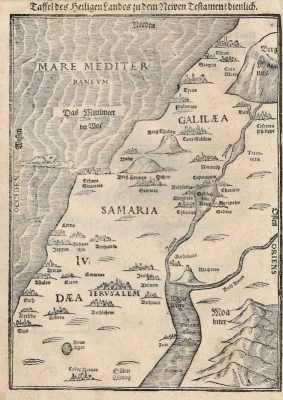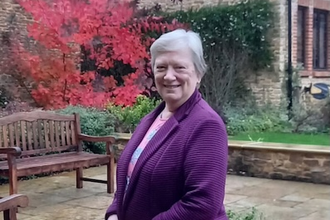Gospel in Art: Jesus left Nazareth and lived in Capernaum in the territory of Zebulun

Holy Land Map by Heinrich Bünting, from Tafel des Heiligen Landes zu dem Neuen Testament dienlich, 1582, woodcut print © Christian Art
Source: Christian Art
Gospel of 6 January 2025
Matthew 4:12-17, 23-25
At that time: When Jesus heard that John had been arrested, he withdrew into Galilee. And leaving Nazareth he went and lived in Capernaum by the sea, in the territory of Zebulun and Naphtali, so that what was spoken by the prophet Isaiah might be fulfilled: 'The land of Zebulun and the land of Naphtali, the way of the sea, beyond the Jordan, Galilee of the Gentiles - the people dwelling in darkness have seen a great light, and for those dwelling in the region and shadow of death, on them a light has dawned.' From that time Jesus began to preach, saying, 'Repent, for the kingdom of heaven is at hand.'
And he went throughout all Galilee, teaching in their synagogues and proclaiming the gospel of the kingdom and healing every disease and every affliction among the people. So his fame spread throughout all Syria, and they brought him all the sick, those afflicted with various diseases and pains, those oppressed by demons, those having seizures, and paralytics, and he healed them. And great crowds followed him from Galilee and the Decapolis, and from Jerusalem and Judea, and from beyond the Jordan.
Reflection on the printed map
Our Gospel reading today mentions several locations: Galilee, Capernaum, Nazareth, Zebulun and Naphtali, Jordan, and Syria. With all these geographical details, Matthew is emphasising that Jesus was a real person who lived in a specific place and at a particular moment in history. It doesn't get anymore real than this. The passage describes the beginning of Jesus' ministry as he leaves Nazareth and settles in Capernaum, a bustling fishing and trading centre on the shores of the Sea of Galilee.
Just as we use road maps when travelling to understand the routes, local culture, and points of interest, it can be invaluable to refer to maps when reading Scripture. The more we understand the geography of the Bible, the more insight we gain into its context and message and the more poignant a the stories become.
The map of the Holy Land we're examining includes most of the locations mentioned in today's Gospel: the Sea of Galilee in the centre-left, Capernaum at the northern edge of the lake, the River Jordan, Samaria, Jerusalem, and beyond. This particular map was published in 1582 by Heinrich Bünting, a Protestant pastor and theologian. It comes from a book that provides an overview of biblical geography, based on the journeys of notable figures from the Old and New Testaments.
Reflecting on this map and the many paths Jesus travelled helps us appreciate the sacrifices and efforts he and his Apostles made to spread the Good News. By visualising these journeys, we deepen our understanding of the challenges they faced and the determination with which they fulfilled their mission.
LINKS
Gospel in Art: https://christian.art/
Today's Reflection: https://christian.art/daily-gospel-reading/matthew-4-12-17-23-25-2025/


















